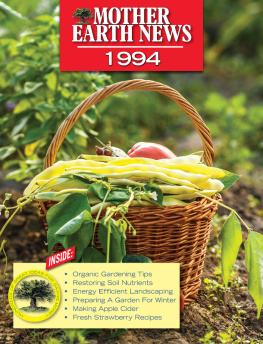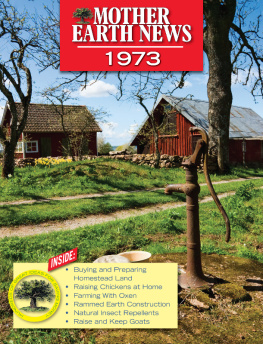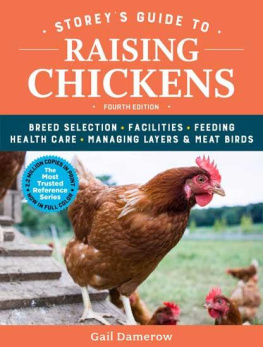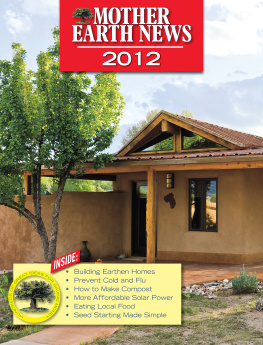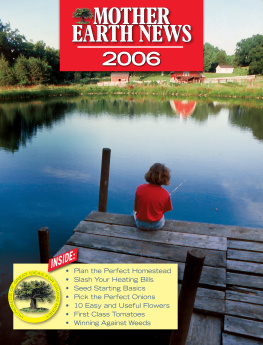Mother Earth News - Mother Earth News 1999
Here you can read online Mother Earth News - Mother Earth News 1999 full text of the book (entire story) in english for free. Download pdf and epub, get meaning, cover and reviews about this ebook. year: 1999, publisher: Mother Earth News, genre: Science / Home and family. Description of the work, (preface) as well as reviews are available. Best literature library LitArk.com created for fans of good reading and offers a wide selection of genres:
Romance novel
Science fiction
Adventure
Detective
Science
History
Home and family
Prose
Art
Politics
Computer
Non-fiction
Religion
Business
Children
Humor
Choose a favorite category and find really read worthwhile books. Enjoy immersion in the world of imagination, feel the emotions of the characters or learn something new for yourself, make an fascinating discovery.
- Book:Mother Earth News 1999
- Author:
- Publisher:Mother Earth News
- Genre:
- Year:1999
- Rating:3 / 5
- Favourites:Add to favourites
- Your mark:
- 60
- 1
- 2
- 3
- 4
- 5
Mother Earth News 1999: summary, description and annotation
We offer to read an annotation, description, summary or preface (depends on what the author of the book "Mother Earth News 1999" wrote himself). If you haven't found the necessary information about the book — write in the comments, we will try to find it.
Mother Earth News 1999 — read online for free the complete book (whole text) full work
Below is the text of the book, divided by pages. System saving the place of the last page read, allows you to conveniently read the book "Mother Earth News 1999" online for free, without having to search again every time where you left off. Put a bookmark, and you can go to the page where you finished reading at any time.
Font size:
Interval:
Bookmark:


Publishers are snatching up our contributors right and left.
A couple of years back, MOTHER introduction readers to twin sisters and Alaskan homesteaders Julie and Miki Collins (An Alaskan Way of Life, January 1996; Cabin on the Twelve-Mile, May 1996). The sisters, who make their home in the wilderness 100 miles north of Anchorage--filling their time (and their cupboards) by trapping, hunting, fishing, and growing their own produce--shared with MEN readers some of the awe-inspiring challenges and rewards of their traditional bush lifestyle. Now, in a new book entitled Riding the Wild Side of Denali:Alaska Adventures with Horses and Huskies (Epicenter Press, $14.95), the Collins sisters expand upon their adventures in the vast and often treacherous landscape they call home.
Also new to bookstores is Healing Plants: A Medicinal Guide to Native North American Plants and Herbs(Lyons Press, $16.95), by MOTHER author Ana Nez Heatherley (Medicines as Close as Your Door, July 1995). A former registered nurse, Heatherley eventually left the field to pursue herbal medicine--an interest inherited from her Celtic grandmother, a healer versed in the use of herbs, and her Cherokee mother, also a practitioner of natural healing.
Healing Plants is a concise encyclopedia of medicinal herbs and plants found in North America-from algerita, used to relieve chronic indigestion, fever, and soar throat, to yucca, the dried root of which can be used to make preparations for treating dandruff and other skin problems, sores and sprains.
Accompanying the text are more than 120 vibrant photographs that together comprise a beautiful and useful identification guide appropriate for budding and practiced herbalists alike.
Long-time MOTHER readers may recognize the name Malcolm Mac Wells, a pioneer of earth-sheltered and underground buildings and an early contributor to these pages. Well, admirers of Wells will be glad to hear that Chelsea Green.
Publishing Co. has revived a classic tome by this legendary and visionary archit ect, newly titled The Earth-Sheltered House: An Architects Sketchbook ($24.95). Originally published in 1990 as Underground Buildings, the book spans 26 years and 192 pages, and makes a cogent case for exploiting the thermal properties of earthen walls in conjunction with passive solar energy to create a home thats warm in winter, cool in summer, designed intuitively rather than artificially, and is energy efficient year-round.
Were betting The Earth-Sheltered House is one book that Wells fans, old and new, wont be able to resist digging into.--M.L.
Call MOTHERS Bookshelf at 1-800-8889098 to order your copy of The Earth-Sheltered House (book number MEB272) or Healing Plants (book number MEB 2711.)
BITS & PIECES
WIND
The U.S. currently has more than 1,600 megawatts of installed windpower generation capacity. This generation capacity produces about three billion kilowatt-hours of electricity each year. Thats enough electricity to meet the annual residential electricity needs of more than one million people.
More than 90% of the total wind power produced in the U.S. is generated by three West Coast wind farms (located in Altamont Pass in northern California and Tehachapi and Palm Springs in southern California).
The U.S. possesses enough useable wind resource to produce more electricity than the nation currently uses. The majority of this usable resource blows across the Great Plains region. North Dakota alone has enough suitable wind resource to supply 36% of the electricity consumed in the U.S.
SOLAR
The U.S. annually uses more than 71 trillion British Thermal Units (BTUs) of solar energy (1 million BTUs equals 90 pounds of coal or eight gallons of gasoline). The residential and commercial sectors use 60 trillion BTUs, the industrial - sector 11 trillion BTUs, and utilities 500 billion BTUs. In the last seven years, photovoltaic sales have nearly tripled. More than 84 megawatts of modules were manufactured worldwide in 1995.
GEOTHERMAL
U.S. geothermal power plants currently have a total electricity generation capacity of 2,700 megawatts. This is enough electricity to meet the residential electricity needs of more than 3.5 million people. Most of the countrys geothermal resources are located in the western U.S. In fact, the worlds largest geothermal power plant--the Geysers Power Plant in northern California--generates more than 1,700 megawatts of power. Known geothermal reserves could supply the entire country with electricity for 30 years.
HYDROELECTRIC
The U.S. is the worlds leading producer of hydroelectric power. Hydropower currently provides 92,000 megawatts of electricity generating capacity in the U.S.-- enough to meet the needs of 28 million households. This represents about 10% of the nations total electricity generation capacity and accounts for almost 50% of all renewable energy used in the U.S. These percentages are unlikely to increase. There are few good sites left to build new large dams, and there is widespread opposition on environmental grounds to the building of new dams.
The nations largest hydropower plant is the 7,600-megawatt Grand Coulee power station located on the Columbia River in Washington state. The plant is being scaled up to 10,080 megawatts, which will place it second in the world behind a colossal 13,320-megawatt plant in Brazil.
BIOMASS
U.S. utilities use biomass to generate more than 7,500 megawatts of electricity.
This is enough power to meet the energy needs of several million households. Today, various forms of biomass energy account for nearly 4% of all energy consumed, and 45% of renewable energy used, in the United States. Biomass currently supplies 2% of the electricity used in California. It is more expensive than other sources of electricity, principally because it is costly to transport fuel from its source to the incinerator.
--From Utility Guide: The Information Network for Utility Users (http//www.utilityguide.com/index.html).
BITS & PIECES
Before the city of Hammond, Indiana, started a clever new strategy for recycling the 400 trees it removed for residents each year, the downed wood was hauled to city landfills and left to rot. But when Lake County Solid Waste Management District Executive Director Jeff Langbehn visited the local Hoosier Sawmill in early 1997, he got to talking with mill operators about a win-win deal for everyone.
Now Hammond, located 33 miles southeast of Chicago, Illinois, has found a way to use these fallen trees--becoming a working template for cities across the nation that are letting valuable resources go to waste.
The old system cost the city in many ways: loss of landfill space, loss of valuable wood, loss of clean air due to methane gas produced by tree decay, and more than $100,000 a year in hauling and dumping fees.
With the new plan, dubbed Trees to Furniture, the city takes the trees to Hoosier Sawmill to be milled into usable lumber, rather than hauling them to a landfill. The sawmill keeps 70% of the wood for compensation, and the other 30% is transformed into city picnic tables, park benches, garden sheds, and more.
Font size:
Interval:
Bookmark:
Similar books «Mother Earth News 1999»
Look at similar books to Mother Earth News 1999. We have selected literature similar in name and meaning in the hope of providing readers with more options to find new, interesting, not yet read works.
Discussion, reviews of the book Mother Earth News 1999 and just readers' own opinions. Leave your comments, write what you think about the work, its meaning or the main characters. Specify what exactly you liked and what you didn't like, and why you think so.




